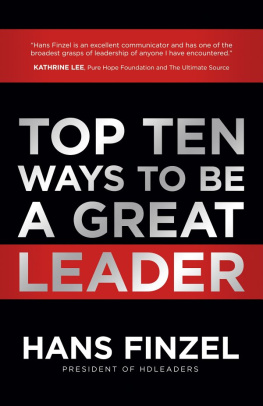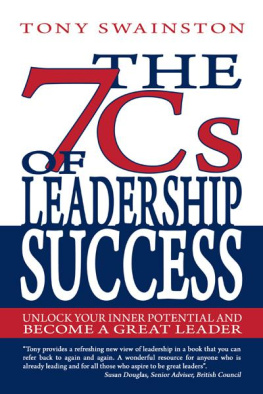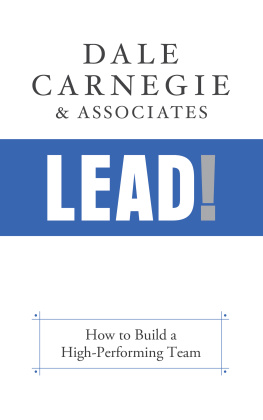
Empowered
LEADERS
Empowered
THE TEN PRINCIPLES OF CHRISTIAN LEADERSHIP
LEADERS
Hans FINZEL
FOREWORD BY CHARLES R. SWINDOLL

EMPOWERED LEADERS
Copyright 1998 by W Publishing Group. All rights reserved.
Published by W Publishing Group, a Division of Thomas Nelson, Inc.,
P. O. Box 141000, Nashville, Tennessee 37214. All rights reserved. No portion of this book may be reproduced, stored in a retrieval system, or transmitted in any form or by any meanselectronic, mechanical, photocopy, recording, or any otherexcept for brief quotations in printed reviews, without the prior permission of the publisher.
Unless otherwise indicated, Scripture quotations used in this book are from the Holy Bible, New International Version (NIV), copyright 1973, 1978, 1984, International Bible Society.
Used by permission of Zondervan Bible Publishers.
Published in association with Dallas Theological Seminary (DTS):
The theological opinions expressed by the author are not necessarily the official position of Dallas Theological Seminary.
ISBN 0-8499-4384-1 (tp)
ISBN 0-8499-9136-6 (se)
Printed in the United States of America
05 06 07 08 09 RRD 9 8 7 6 5 4 3 2 1
DEDICATION
To the leadership team
of CBInternational
I cant imagine working day by day
with a more gifted, committed, and yet humble
group of servant leaders.
You make leadership truly rewarding.
CONTENTS
T AKE ONE GLANCE at this book and you quickly discover this is not simply another book on leadership. This is no old, worn-out dolly dressed up in new clothes. For one of those, just stop by a crowded airport newsstand and glance over the choice of books on leadership for today.
If youre like me, youve grown weary of the published cookie-cutter approaches on how to lead effectively. Somehow the church has aligned itself with Wall Street and traded its eternal values for matters better suited for leaders of microchip companies and ad agencies. Ive gotten tired of all the hype surrounding church growth. And so has Hans Finzel. Instead he drills to the core, answering questions like, What is the real biblical model of leadership? Does character matter? What qualities truly count for the Christian leader today?
Refreshingly, with superb skill and an unusual knack for drawing you into his own experience, Finzel simply states that our only hope for finding clear direction in the soupy malaise of postmodern leadership theory is to refocus on the absolutely reliable compass of Gods Word. Its about time someone said that.
So with the right compass in hand, the author steadily guides his readers on a satisfying journey toward rediscovering the timeless and rewarding disciplines of meditating on the Scriptures, prayer, and cultivating the inner spiritual life. To Finzel, integrity does matter. So he gently reminds us of the importance of pursuing such goals as character, creativity, and encouragement in leadership. All his discussions are carefully grounded in the Scriptures. And all his insights are seasoned with delightful real-life stories that not only convince, but refresh the weary soul like a tonic.
Highlighting such mammoth biblical leaders as Moses, Joseph, and David, this careful student of the Word emphasizes the often-missed truth that leaders are never perfect. Yet the best ones are authentic, and thus are usable by God. In other words effective leaders have feet of clay, but deep within are hearts of pure gold. The magnificent result is that the character studies in this book are full of fresh insightsinsights that provide principles for effective leadership that you and I can implement and measure in any Christian setting.
You cant discern how to become an effective Christian leader merely by studying charts and analyzing demographic reports. True leadership is about understanding God, yourself, and those whom He has called you to lead. That takes time. And it takes prayer. And more time and more prayer. In the nucleus of such disciplines is a deep commitment to a life of studying and applying Gods Word.
So locate your compass and prepare yourself for an unforgettable journey. You will soon be on your way to the fulfilling land of effective leadership. With Hans Finzel as your guide, I am convinced you will arrive there encouraged and wiser!
CHARLES R. SWINDOLL
General Editor
T HIS PROJECT WAS A BIG JOB in the midst of a hectic life. A special thank you goes to my wife, Donna, a wonderful life companion for these twenty-three years, who helped make this manuscript come together. On top of the pressure of running the Finzel household with our two teenagers and ten-year-old twins, and covering the home front during all my travels, she gave many hours to editing and revising this manuscript. Her gifts in writing and insights into leadership have made a big difference, and for that I am very grateful. Thanks for spending all those hours in front of the computer, for your excellent feedback, for believing in me, and for always being there to make us successful as partners for life.
L EADERSHIP IS DANGEROUS WORK. Just ask Captain Smith. On Sunday, April 14, 1912, a calm moonless night, the temperature was just about at the freezing mark. Inside, the passengers were enjoying a lovely dinner in the warm lively atmosphere of the newly christened Titanic.
Meanwhile in the wireless room Jack Phillips and Harold Bride were busy receiving ice warnings from other ships in the area. These messages were passed on to Captain Smith and the officers, who regarded them as normal warnings for this time of year and no threat to the Titanic. When the Titanic came in contact with Cape Race, Newfoundland, around 9:30 P.M., the wireless room became very busy sending passengers routine messages to friends, relatives, and business contacts. During this time the most important ice warnings were ignored. The steamer Mesaba sent an urgent message, reporting that a large icefield lay in the direction in which the Titanic was headed.
Up in the crows nest Frederick Fleet was staring into the darkness. Around 11:30 P.M., he noticed a black object immediately in their path. He urgently called the iceberg warning down to the officer in charge.
On the bridge First Officer Murdoch ordered full speed astern and hard a starboard. Slowly the ship began to turn and it looked as if it would clear the ice. When they heard a strange scraping noise, Murdoch knew they had hit an iceberg, a seamans worst nightmare. He then ordered the watertight doors shut.
Shortly after the collision Thomas Andrews, master builder of the ship, met with Captain Smith and gravely informed him that the Titanic was doomed. Over two hundred feet of the ship had been sliced open by the iceberg, and the first six watertight compartments were flooding.
Knowing his ship was sinking, Captain Smith ordered the evacuation of the Titanic. Their greatest problem was that the Titanic carried only enough lifeboats for about half the twenty-two hundred people on board. Meanwhile the wireless operators were sending distress calls indicating the Titanics position.
She went under at 2:20 A.M., less than three hours after striking the ice. Shortly after, all cries for help fell silent. All that was left of that greatest of passenger ships were partially filled lifeboats floating in a sea of blackness.
For Captain Smith, who went down with the ship
Next page











